 | | | Switch to: Europe, USA, New Zealand, Antarctica Credit: NOAA/Ovation  Planetary K-index Planetary K-index
Now: Kp= 0 quiet
24-hr max: Kp= 2 quiet
explanation | more data
Interplanetary Mag. Field
Btotal: 2.9 nT
Bz: 0.9 nT north
more data: ACE, DSCOVR
Updated: Today at 2348 UT  Coronal Holes: 24 May 17 Coronal Holes: 24 May 17 
There are no large coronal holes on the Earth-facing side of the sun.. Credit: NASA/SDO.  Noctilucent Clouds The southern season for noctilucent clouds began on Nov. 17, 2016. Come back to this spot every day to see the "daily daisy" from NASA's AIM spacecraft, which is monitoring the dance of electric-blue around the Antarctic Circle. Switch view: Ross Ice Shelf, Antarctic Peninsula, East Antarctica, Polar Updated at: 02-24-2017 17:55:02 Noctilucent Clouds The southern season for noctilucent clouds began on Nov. 17, 2016. Come back to this spot every day to see the "daily daisy" from NASA's AIM spacecraft, which is monitoring the dance of electric-blue around the Antarctic Circle. Switch view: Ross Ice Shelf, Antarctic Peninsula, East Antarctica, Polar Updated at: 02-24-2017 17:55:02  SPACE WEATHER
NOAA Forecasts | | Updated at: 2017 May 24 2200 UTC FLARE | 0-24 hr | 24-48 hr | CLASS M | 01 % | 01 % | CLASS X | 01 % | 01 % |  Geomagnetic Storms: Geomagnetic Storms:
Probabilities for significant disturbances in Earth's magnetic field are given for three activity levels: active, minor storm, severe storm Updated at: 2017 May 24 2200 UTC Mid-latitudes | 0-24 hr | 24-48 hr | ACTIVE | 10 % | 20 % | MINOR | 01 % | 05 % | SEVERE | 01 % | 01 % | High latitudes | 0-24 hr | 24-48 hr | ACTIVE | 15 % | 15 % | MINOR | 15 % | 20 % | SEVERE | 10 % | 20 % | | | |  | | | | | | | | | | | Lights Over lapland is excited to announce that Autumn Aurora Adventures are available for immediate booking! Reserve your adventure of a lifetime in Abisko National Park, Sweden today! | | | CME TO SIDESWIPE EARTH THIS WEEK: On Tuesday, May 23rd, the orbiting Solar and Heliospheric Observatory observed a CME leaving the sun: movie. NOAA analysts say the plasma-filled cloud could deliver a glancing blow to Earth's magnetic field midday on May 26th, causing geomagnetic unrest and polar auroras. Free: Aurora Alerts HEDGEROW PROMINENCE: Yesterday, Randy Shivak of Prescott Valley, Arizona, pointed his solar telescope at the sun ... and this is what he saw: 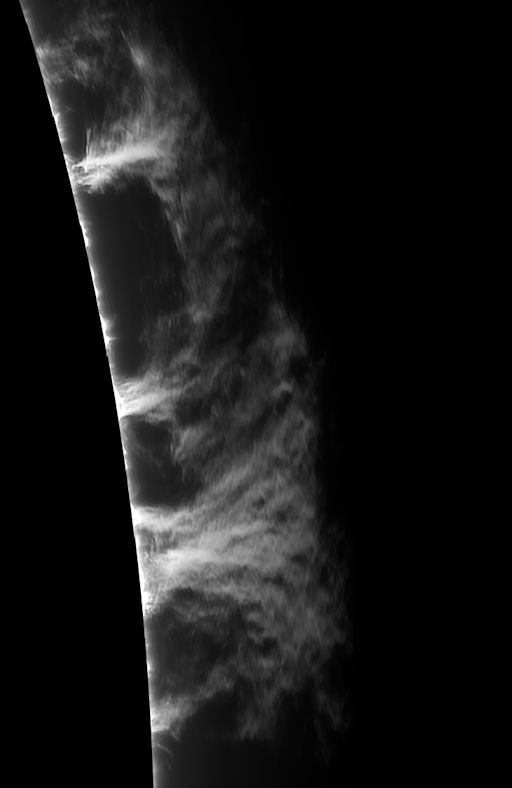
"There is a very large prominence on the sun's western limb," he says.
The structure is 5 times taller than Earth, and if you put one end on our planet, the other end would stretch beyond the orbit of the Moon more than 400,000 km away. "Very large" indeed.
This is a type of prominence commonly called a "hedgerow prominence." Hot glowing plasma inside the structure is held aloft by unstable solar magnetic fields. NASA and Japanese space telescopes have taken high resolution images of similar prominences and seen some amazing things such as (1) tadpole-shaped plumes that float up from the base of the prominence; (2) narrow streams of plasma that descend from the top like waterfalls; and (3) swirls and vortices that resemble van Gogh's Starry Night. It's still there today. Got a solar telescope? Take a look! Realtime Space Weather Photo Gallery STEVE, IN MOTION: On May 19th and 20th, a solar wind stream hit Earth's magnetic field. The impact summoned "Steve"--a mysterious form of filamentary aurora that researchers do not fully understand. "I saw 'Steve' through the window even though the lights were still on in the house, so it must have been quite bright," reports Matthew Wheeler of Robson Valley, BC, Canada. Grabbing his camera, he rushed outside for a better view, and captured a rare movie of Steve in motion: 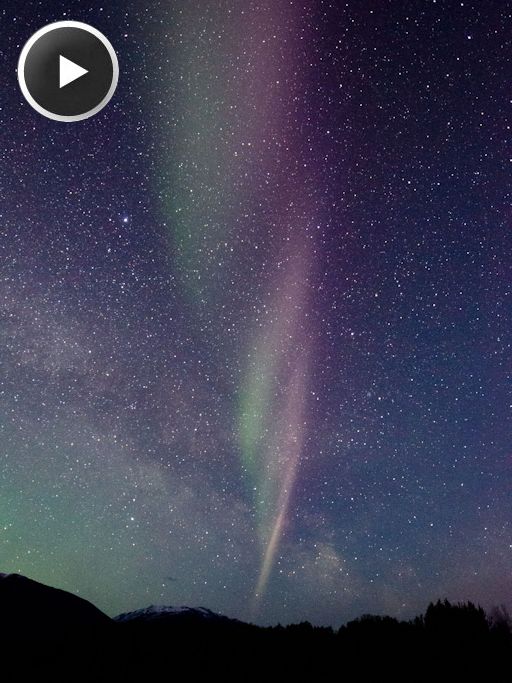
"I have seen Steve here a few times in the past decades," says Wheeler. "This was a dramatic apparition, especially overhead where fine fingers of color moved very fast almost at right angles to Steve, quite finely detailed at times. The 10 second exposures I stitched together to make the animation don't do it justice."
When will Steve appear again? No one can say. While you wait, browse the Realtime Steve Gallery for more sightings: Realtime "Steve" Photo Gallery
THIS PENDANT HAS TOUCHED SPACE: The radiation monitoring program of Earth to Sky Calculus receives no support from corporate sponsors or government grants. Instead, we are crowd-funded. Or, to be more precise, bling-funded: 
To raise money for more cosmic ray balloon flights, on May 6th the students launched a payload of these Northern Lights pendants to the top of Earth's atmosphere. You can have one for $79.95. Each piece of space jewelry comes with a greeting card showing the item in flight and telling the story of its journey to the stratosphere and back. They make great birthday and belated Mother's Day gifts. More far-out gifts may be found in the Earth to Sky Store. All proceeds support atmospheric radiation monitoring and hands-on STEM education. Realtime Space Weather Photo Gallery
Realtime Comet Photo Gallery
Realtime Aurora Photo Gallery Every night, a network of NASA all-sky cameras scans the skies above the United States for meteoritic fireballs. Automated software maintained by NASA's Meteoroid Environment Office calculates their orbits, velocity, penetration depth in Earth's atmosphere and many other characteristics. Daily results are presented here on Spaceweather.com. On May. 24, 2017, the network reported 19 fireballs.
(19 sporadics) 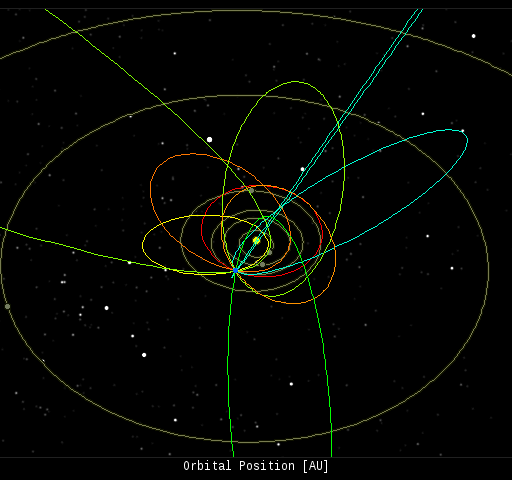 In this diagram of the inner solar system, all of the fireball orbits intersect at a single point--Earth. The orbits are color-coded by velocity, from slow (red) to fast (blue). [Larger image] [movies] Potentially Hazardous Asteroids ( PHAs) are space rocks larger than approximately 100m that can come closer to Earth than 0.05 AU. None of the known PHAs is on a collision course with our planet, although astronomers are finding new ones all the time. On May 24, 2017 there were 1803 potentially hazardous asteroids.  | Recent & Upcoming Earth-asteroid encounters: | Asteroid | Date(UT) | Miss Distance | Velocity (km/s) | Diameter (m) | | 2017 KY4 | 2017-May-20 | 2.5 LD | 9.3 | 42 | | 2017 KH3 | 2017-May-24 | 18.7 LD | 20 | 62 | | 2017 KW4 | 2017-May-25 | 3.9 LD | 13 | 29 | | 2017 CS | 2017-May-29 | 8 LD | 9.1 | 468 | | 418094 | 2017-Jun-01 | 8 LD | 23.2 | 490 | | 2017 KX4 | 2017-Jun-01 | 15.3 LD | 9.5 | 46 | | 2017 KJ3 | 2017-Jun-03 | 11.1 LD | 11.2 | 49 | | 2017 HV4 | 2017-Jun-10 | 19.5 LD | 3.9 | 51 | | 2017 KF3 | 2017-Jun-11 | 12.9 LD | 11.2 | 40 | | 2010 VB1 | 2017-Jun-16 | 10.3 LD | 8.3 | 81 | | 471984 | 2017-Jun-18 | 19.1 LD | 7.7 | 102 | | 441987 | 2017-Jun-24 | 7.9 LD | 12.7 | 178 | Notes: LD means "Lunar Distance." 1 LD = 384,401 km, the distance between Earth and the Moon. 1 LD also equals 0.00256 AU. MAG is the visual magnitude of the asteroid on the date of closest approach. | | Cosmic Rays in the Atmosphere |
Readers, thank you for your patience while we continue to develop this new section of Spaceweather.com. We've been working to streamline our data reduction, allowing us to post results from balloon flights much more rapidly, and we have developed a new data product, shown here: 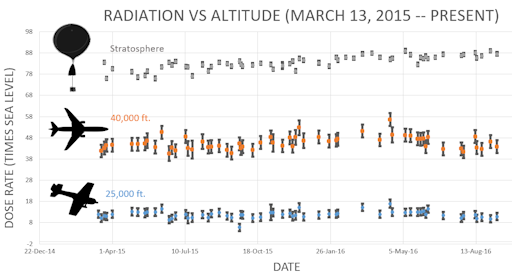
This plot displays radiation measurements not only in the stratosphere, but also at aviation altitudes. Dose rates are expessed as multiples of sea level. For instance, we see that boarding a plane that flies at 25,000 feet exposes passengers to dose rates ~10x higher than sea level. At 40,000 feet, the multiplier is closer to 50x. These measurements are made by our usual cosmic ray payload as it passes through aviation altitudes en route to the stratosphere over California. What is this all about? Approximately once a week, Spaceweather.com and the students of Earth to Sky Calculus fly space weather balloons to the stratosphere over California. These balloons are equipped with radiation sensors that detect cosmic rays, a surprisingly "down to Earth" form of space weather. Cosmic rays can seed clouds, trigger lightning, and penetrate commercial airplanes. Furthermore, there are studies ( #1, #2, #3, #4) linking cosmic rays with cardiac arrhythmias and sudden cardiac death in the general population. Our latest measurements show that cosmic rays are intensifying, with an increase of more than 13% since 2015: 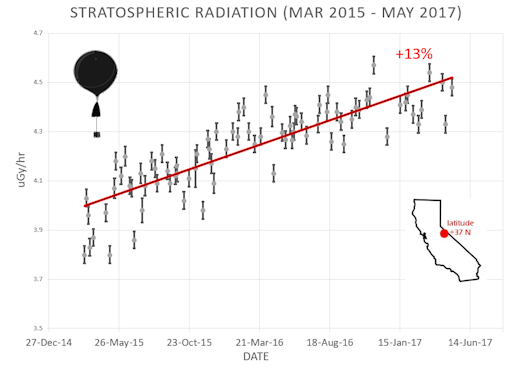
Why are cosmic rays intensifying? The main reason is the sun. Solar storm clouds such as coronal mass ejections (CMEs) sweep aside cosmic rays when they pass by Earth. During Solar Maximum, CMEs are abundant and cosmic rays are held at bay. Now, however, the solar cycle is swinging toward Solar Minimum, allowing cosmic rays to return. Another reason could be the weakening of Earth's magnetic field, which helps protect us from deep-space radiation. The radiation sensors onboard our helium balloons detect X-rays and gamma-rays in the energy range 10 keV to 20 MeV. These energies span the range of medical X-ray machines and airport security scanners. The data points in the graph above correspond to the peak of the Reneger-Pfotzer maximum, which lies about 67,000 feet above central California. When cosmic rays crash into Earth's atmosphere, they produce a spray of secondary particles that is most intense at the entrance to the stratosphere. Physicists Eric Reneger and Georg Pfotzer discovered the maximum using balloons in the 1930s and it is what we are measuring today. | | The official U.S. government space weather bureau | | | The first place to look for information about sundogs, pillars, rainbows and related phenomena. | | | Researchers call it a "Hubble for the sun." SDO is the most advanced solar observatory ever. | | | 3D views of the sun from NASA's Solar and Terrestrial Relations Observatory | | | Realtime and archival images of the Sun from SOHO. | | | from the NOAA Space Environment Center | | | a proud supporter of science education and Spaceweather.com | | | fun to read, but should be taken with a grain of salt! Forecasts looking ahead more than a few days are often wrong. | | | from the NOAA Space Environment Center | | | the underlying science of space weather |  | Beautyz for top beauty products reviews and their buying guides |  | Reviews here can help you to pick up best memory foam mattresses. | | | These links help Spaceweather.com stay online. Thank you to our supporters! | | | | | | | | |  | |  |   | ©2016 Spaceweather.com. All rights reserved. This site is penned daily by Dr. Tony Phillips. | |

